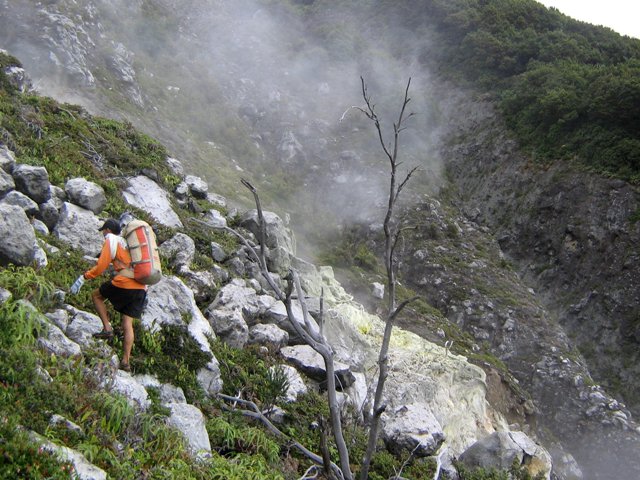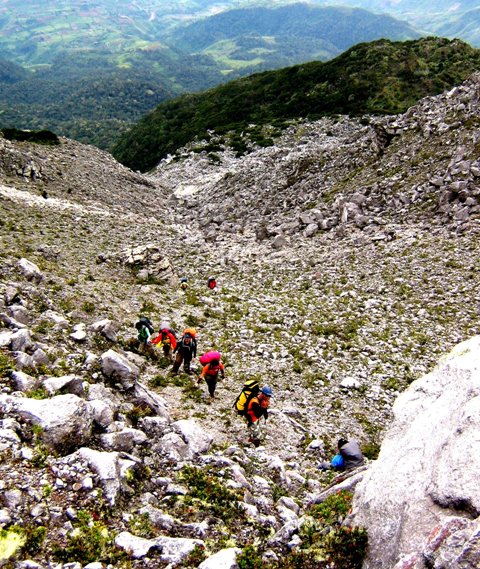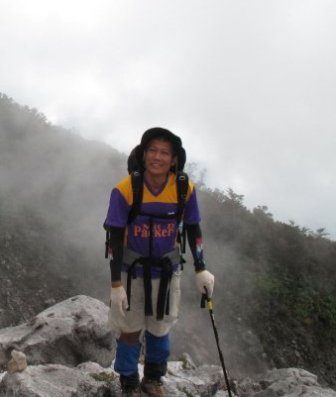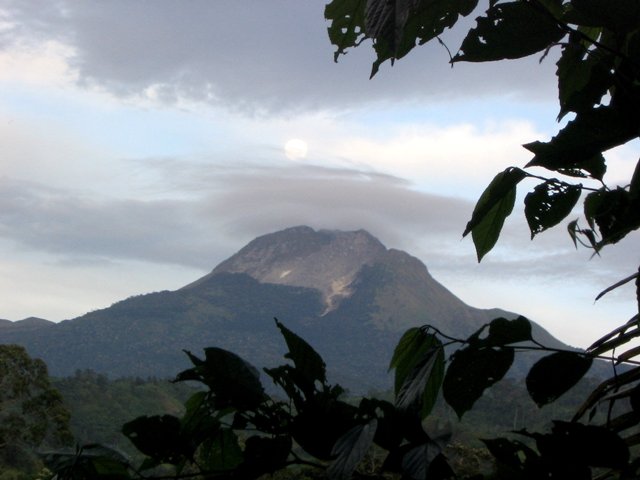Mount Apo by moonlight
From the south and east it looks like a worn crown badly in need of dental remedy. The reddish glow of the dawn light bounces off its flanks, through a wide skirt of cottony clouds and down to the distant rows of banana, durian, pomelo, pineapple and other high-value cash crops planted by hundreds of thousands of farmers who live on the lower foothills of the Philippines' tallest mountain. When I grow old and grey, when bone and sinew will decay and I will no longer be able to climb mountains, I will be content in being able to tell my grandchildren that the view, only available to a select few, is much grander from up close: that the wide white gash is really a series of giant rockfalls that takes up to half a day to cover; that some of the rocks are as big as houses; that the ground oozes a heated, foul-smelling steam that eventually fries all living things above it; and that a hardy shrub with tiny red flowers clings to life between the cracks, supplying a black, edible berry -- emergency sucrose that helps you vault past an imposing 87-degree crater wall just beneath the summit.  We used much of the same trail as the one the previous year, climbing by way of the sprawling village of Sibulan in Santa Cruz, south of Davao City. The boulder field -- all 500 vertical meters of it, beginning at about 2,270 meters above sea level -- looked as if it grew by several acres (below) since my last visit. There was a large patch of dead trees and bush on the left side where new sulphur vents (right) had opened up. This is a potentially active volcano, lest we forget. I told TB, who was enjoying his new REI tent, that it took just 16 minutes for me to climb the 95-metre crater wall.
We used much of the same trail as the one the previous year, climbing by way of the sprawling village of Sibulan in Santa Cruz, south of Davao City. The boulder field -- all 500 vertical meters of it, beginning at about 2,270 meters above sea level -- looked as if it grew by several acres (below) since my last visit. There was a large patch of dead trees and bush on the left side where new sulphur vents (right) had opened up. This is a potentially active volcano, lest we forget. I told TB, who was enjoying his new REI tent, that it took just 16 minutes for me to climb the 95-metre crater wall.  On the way down the presence of the guides allowed me and Francis to go skipping atop the rocks in search of the straightest line without straying too far from our self-imposed roles at the rear of our groups. Long legs do help but confidence, balance, and daring are the key. The trick is to stay above the rocks to achieve a level course, avoiding the trap of using the deep spaces in between boulders, which ultimately wastes time and effort because you would have to climb your way out of them again. Sibulan is Bagobo country, who get their electricity from dams built along a river of the same name. The Philippines has few flat plains, so at least a fifth of the population move uphill to clear tracts of forest to turn into farmlands. Around the trailhead of Baroring and nearby Colan, the last community before the forest line, pack horses laden with carrots and trucks filled with cabbages kick up dirt on rutted roads past plots of potatoes and hillsides carpeted in vegetable pear vines that could easily be mistaken for some highland Benguet farm up north. It was much wetter than in my last visit here, but the same orange flowers, the same wild peas with lilac blooms abound along the trail and on patches of clearings. But this was much shorter overall than the previous climb’s trail -- just two full days and two half days, a mere three-fourths of the traditional Sibulan trail. Venado lake is flooded on the other side, ruling out a longer loop, but also maybe because more roads are being built and more land is being cleared to make way for farms and new communities. Walking through them would be a bore by comparison.
On the way down the presence of the guides allowed me and Francis to go skipping atop the rocks in search of the straightest line without straying too far from our self-imposed roles at the rear of our groups. Long legs do help but confidence, balance, and daring are the key. The trick is to stay above the rocks to achieve a level course, avoiding the trap of using the deep spaces in between boulders, which ultimately wastes time and effort because you would have to climb your way out of them again. Sibulan is Bagobo country, who get their electricity from dams built along a river of the same name. The Philippines has few flat plains, so at least a fifth of the population move uphill to clear tracts of forest to turn into farmlands. Around the trailhead of Baroring and nearby Colan, the last community before the forest line, pack horses laden with carrots and trucks filled with cabbages kick up dirt on rutted roads past plots of potatoes and hillsides carpeted in vegetable pear vines that could easily be mistaken for some highland Benguet farm up north. It was much wetter than in my last visit here, but the same orange flowers, the same wild peas with lilac blooms abound along the trail and on patches of clearings. But this was much shorter overall than the previous climb’s trail -- just two full days and two half days, a mere three-fourths of the traditional Sibulan trail. Venado lake is flooded on the other side, ruling out a longer loop, but also maybe because more roads are being built and more land is being cleared to make way for farms and new communities. Walking through them would be a bore by comparison.  Still, the remaining green cover is marvelous. Birdsong resonates beneath the canopy in between the lower Tinikaran campsite and the upper limit of the forest. Imagine the things you would miss out on if you chose to walk with ear buds on and listened to canned music instead. At times I would want to stop just to soak up the sensory overload. On a training climb though, especially with a team leader who follows the timetable with military precision, there is no chance of that happening. I counted at least five types of crickets or cicadas or frogs, judging by the mating calls, at dusk as I trudged in the dark, headlamp off, for about a quarter of an hour behind the fragmented rear guards of two climbing groups. To get to know the forest by ear, I pushed ahead on my own as light failed, after growing weary of taking group sweep duties for my team. It was not much of a problem because our group leader seemed to grow into that role during that climb, at one point returning to the rear and then carrying two backpacks back towards the front to bridge the growing gap.
Still, the remaining green cover is marvelous. Birdsong resonates beneath the canopy in between the lower Tinikaran campsite and the upper limit of the forest. Imagine the things you would miss out on if you chose to walk with ear buds on and listened to canned music instead. At times I would want to stop just to soak up the sensory overload. On a training climb though, especially with a team leader who follows the timetable with military precision, there is no chance of that happening. I counted at least five types of crickets or cicadas or frogs, judging by the mating calls, at dusk as I trudged in the dark, headlamp off, for about a quarter of an hour behind the fragmented rear guards of two climbing groups. To get to know the forest by ear, I pushed ahead on my own as light failed, after growing weary of taking group sweep duties for my team. It was not much of a problem because our group leader seemed to grow into that role during that climb, at one point returning to the rear and then carrying two backpacks back towards the front to bridge the growing gap.  It was my first time to camp on Apo's summit, and for once, the club was blessed with clear weather. A pale full moon hovered between the two clumps of rock on the main summit just before sunset as I took up sentry duties for my group. Most of them were climbing this mountain for the first time, and they went up a secondary summit to observe the red orb sink into the Cotabato basin. There were at least four groups at the summit on Hallows Eve, including a stray South Korean climber and a team of college students from Bukidnon. But our group had the best patch of real estate, courtesy of Bado our guide, who carried a pile of stuff sacks suspended on an ingenious contraption of polyvinyl chloride pipes, a homemade external frame pack if ever there was one. Our tents were sheltered from the high winds and had a thick carpet of soft grass beneath the floor. We had the summit's only cave for a kitchen area, and we used my parawing as a blind to shield its mouth. The tall grass was wet but it was almost like daylight in late evening as Ike, Roger, Macoy and I fanned out armed with trowels, watching the headlamps flicker behind the bushes like ship-to-shore signals. – YA, GMA News The author is a 50-year old news editor who climbs mountains for fun with people half his age. He has averaged one Philippine peak every month since he joined the AMCI Mountaineering Club in July 2006, and will climb Mount Apo again this Halloween. Photos courtesy of the author. This article was shortened and reprinted with permission from Cecil Morella’s blog.
It was my first time to camp on Apo's summit, and for once, the club was blessed with clear weather. A pale full moon hovered between the two clumps of rock on the main summit just before sunset as I took up sentry duties for my group. Most of them were climbing this mountain for the first time, and they went up a secondary summit to observe the red orb sink into the Cotabato basin. There were at least four groups at the summit on Hallows Eve, including a stray South Korean climber and a team of college students from Bukidnon. But our group had the best patch of real estate, courtesy of Bado our guide, who carried a pile of stuff sacks suspended on an ingenious contraption of polyvinyl chloride pipes, a homemade external frame pack if ever there was one. Our tents were sheltered from the high winds and had a thick carpet of soft grass beneath the floor. We had the summit's only cave for a kitchen area, and we used my parawing as a blind to shield its mouth. The tall grass was wet but it was almost like daylight in late evening as Ike, Roger, Macoy and I fanned out armed with trowels, watching the headlamps flicker behind the bushes like ship-to-shore signals. – YA, GMA News The author is a 50-year old news editor who climbs mountains for fun with people half his age. He has averaged one Philippine peak every month since he joined the AMCI Mountaineering Club in July 2006, and will climb Mount Apo again this Halloween. Photos courtesy of the author. This article was shortened and reprinted with permission from Cecil Morella’s blog.




